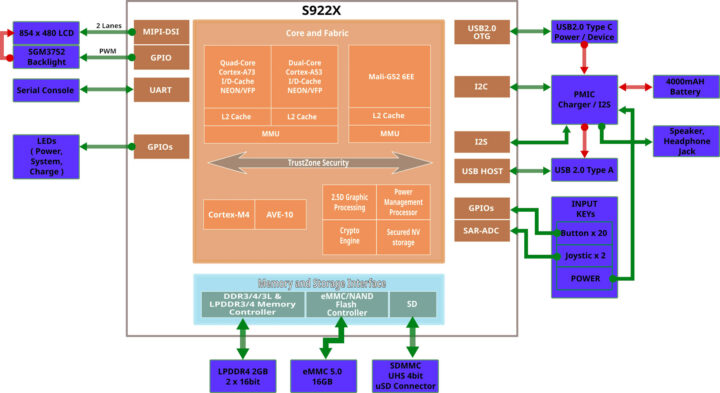Hardkernel ODROID-Go Ultra (OGU) portable gaming console and devkit is powered by the same Amlogic S922X hexa-core Cortex-A73/A53 processor found in the company’s ODROID-N2+ SBC. The new model also adds a 16GB eMMC flash for faster storage and increases the RAM capacity to 2GB.
The Korean company’s adventure with portable gaming consoles started with the ESP32-based ODROID-Go to celebrate its 10th birthday in 2018. At the time it looked like a side project, but the console was popular enough that they released their first Linux handheld game console with the ODROID-Go Advance (OGA) in 2019, and then the ODROID-Go Super (OGS) in 2020 with a larger 5-inch display, and both equipped with a Rockchip RK3326 quad-core Cortex-A35 processor. The new ODROID-Go Ultra is based on the same design as the OGS model, but with a serious jump in performance, and the ability to support more demanding emulators.
ODROID-Go Ultra specifications:
- SoC – Amlogic S922X hexa-core processor with 4x Arm Cortex-73 cores @ up to 2.2 GHz, 2x Cortex-A53 cores @ up to 2.0 GHz, Arm Mali-G52 MP4 @ 846 MHz
- System Memory – 2GB LPDDR4 @ 1608MHz, 32 Bits bus width
- Storage – 16GB eMMC Flash, MicroSD Card slot (UHS-1 capable interface)
- Display – 5-inch 854×480 TFT LCD (MIPI-DSI interface)
- Audio – 3.5mm earphone stereo jack, 0.5 Watt 8Ω Mono speaker
- Connectivity – Optional dual-band WiFi and Bluetooth USB adapter
- USB – 1x USB 2.0 host port, 1x USB Type-C port with data support (same as used for power)
- Buttons – F1, F2, F3, F4, F5, F6, A, B, X, Y, direction pad, left shoulder, right shoulder, 2x analog joysticks, volume buttons
- Expansion – 10-pin header with I2C, GPIO, IRQ at 3.3Volt
- Battery
- 3.7V/4,000mAh Li-Polymer battery
- 6+ hours of continuous game playing time (was 10+ hours on OGS)
- Charging time – 3 to 4 hours when turned off, 6 to 7 hours when in use
- Power Supply – 5V/1.5A max via USB Type-C port; Y-cable provided for faster charging
- Power Consumption
- Idle – > 1mA
- Gaming – 800 to 1300 mA depending on brightness, game played, and wireless usage
- Dimensions – 204 x 86 x 25mm
- Weight – 299 grams


The OGU also has a different power circuitry, and that’s why a Y USB cable has been designed to connect it to both the USB-C and USB-A ports to make the device charge faster. The console runs Ubuntu 20.04.4 with Linux 4.9.277 and a modified EmulationStation front-end with Libretro, OpenGL ES acceleration on DRM-FB.
Hardkernel has tested the console with a range of emulators including atari5200, gb/gba/gbc, mastersystem, megadrive, nes, pcengine, psx, segacd, snes, psp, n64, dreamcast, gamecube, and others. As noted in the introduction, performance should be like night and day with the Amlogic S922X delivering over double the CPU and GPU performance of the Rockchip RK3326 found in earlier models. The main downside should be the shorter battery life, but I suppose six hours is still plenty of time for most people.

The ODROID-Go Ultra portable game console can be purchased for $111 on Hardkernel’s store with either a dim gray or clear white (translucid) enclosure. You may find additional details and/or ask questions in the announcement in odroid forums.
Thanks to Tim for the tip.
Update: Initially published on August 25, 2022 when Hardkernel unveiled the game console/devkit, the article was updated on October 7, 2022 with the availability of the ODROID-Go Ultra.

Jean-Luc started CNX Software in 2010 as a part-time endeavor, before quitting his job as a software engineering manager, and starting to write daily news, and reviews full time later in 2011.
Support CNX Software! Donate via cryptocurrencies, become a Patron on Patreon, or purchase goods on Amazon or Aliexpress





